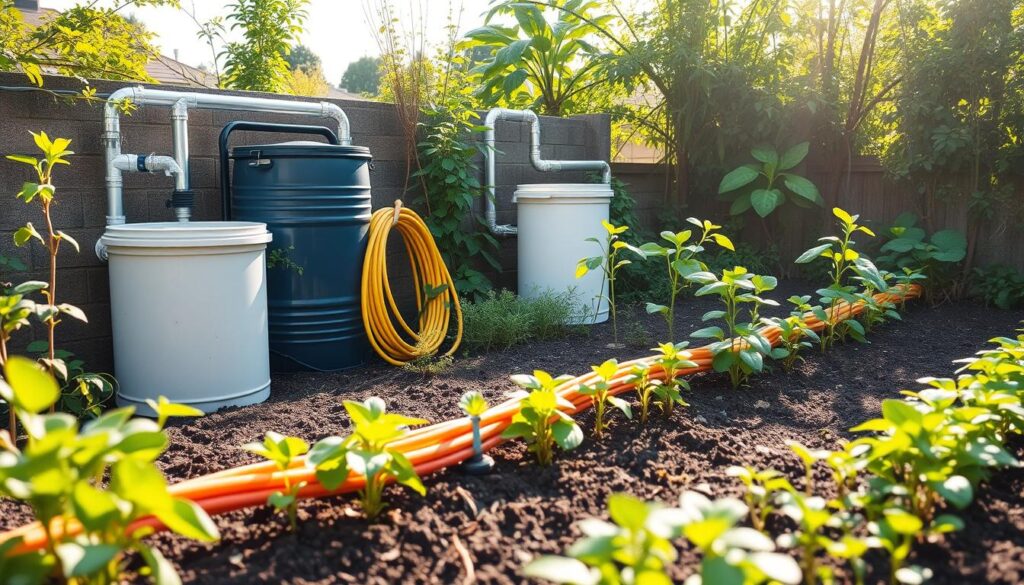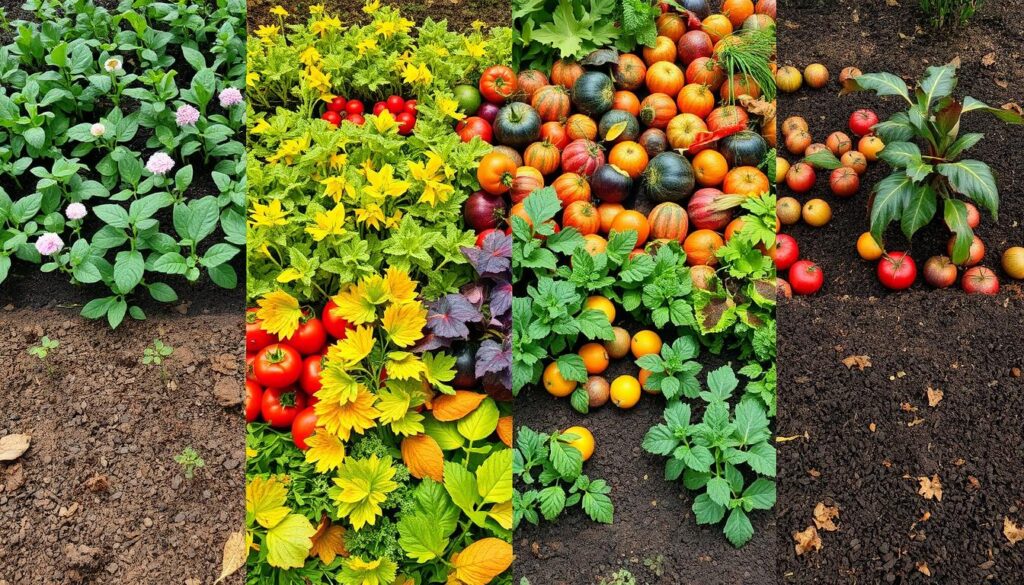Have you ever wondered why gardeners are choosing organic over chemical methods? Organic gardening is key to a sustainable future. It makes our harvest safer and helps us live in harmony with nature. This article will show you how to grow a lush garden without harmful chemicals.
Key Takeaways
- Understand the fundamentals of organic gardening for better yields.
- Explore the importance of non-chemical approaches in gardening practices.
- Learn how to create a thriving environment for plants and beneficial insects.
- Discover effective methods of soil preparation and nutrient management.
- Find sustainable solutions to common gardening challenges.
- Empower yourself with knowledge on seasonal care and maintenance.
What is Organic Gardening?
Organic gardening is about growing plants without synthetic stuff. It means no artificial fertilizers, pesticides, or genetically modified organisms. This way, it keeps the environment balanced, supports many different plants, and makes soil healthy naturally.
Definition and Principles
Organic gardening puts the planet and the gardener first. It’s all about:
- Keeping soil healthy with compost and natural stuff
- Bringing in many plants to attract good bugs
- Using crop rotation and cover crops to keep soil strong
Benefits of Going Organic
Organic gardening is good for you and the planet. Here’s why:
- Improved health: Organic food is full of nutrients and free from bad chemicals.
- Environmental conservation: It cuts down pollution and makes ecosystems healthier.
- Enhanced biodiversity: It supports many plants and animals, keeping nature in balance.
Choosing organic gardening helps the environment and makes you healthier. It’s a journey that’s good for you and the planet.
Choosing the Right Location for Your Garden
When picking the perfect spot for your organic garden, several key factors come into play. These include the right amount of sunlight, protection from wind, and easy access. Each of these elements is vital for the health and success of your garden.
Sunlight Requirements
Most plants need 6-8 hours of direct sunlight each day. To find the best spot, watch how the sunlight changes throughout the day. Choose areas that get enough light for your plants to thrive.
Wind Protection
Strong winds can harm delicate plants. Trees and bushes can act as natural shields. If you don’t have these, consider using fences or windbreaks to protect your garden.
Accessibility and Drainage
It’s important to have easy access to your garden for upkeep. Make sure paths are clear and simple to follow. Also, good drainage is key to prevent waterlogged soil. Watch how water flows after it rains to spot any drainage problems and fix them before planting.
Soil Preparation for Organic Gardening
Preparing soil for organic gardening is key to a thriving garden. Knowing the basics of soil health can boost your gardening success. A few practices can make sure your soil supports strong plant growth.
Testing Soil Health
Testing your soil’s health is essential. It shows the nutrient levels and pH. You can find testing kits at garden stores or through local services. These tests help you know how to improve your soil.
They also tell you about the soil’s microbial life. This info helps you choose the right gardening methods.
Adding Organic Matter
Adding organic matter like compost, peat moss, and manure improves soil. These natural soil improvement techniques add nutrients and help with moisture. Regularly adding these materials boosts soil health and supports a diverse ecosystem.
Techniques for Soil Aeration
Improving soil aeration is crucial. Methods like tilling, double digging, and using cover crops help. They make the soil loose and friable, which is good for roots and nutrient uptake.
Good aeration leads to healthier plants and better garden productivity.
| Soil Health Component | Importance | Methods to Improve |
|---|---|---|
| Nutrient Levels | Supports plant growth | Soil health testing, adding organic matter |
| pH Balance | Affects nutrient availability | Amending with lime or sulfur |
| Microbial Activity | Enhances nutrient cycling | Incorporating organic materials, cover cropping |
| Aeration | Improves root development | Tilling, double digging, aeration tools |
Selecting Organic Seeds and Plants
Choosing the right seeds and plants is key for a thriving organic garden. Organic seeds support sustainable practices and reduce environmental harm. Non-GMO plants are crucial, as they boost biodiversity and protect our ecosystem.
Importance of Non-GMO Seeds
Non-GMO seeds offer many benefits. They are more resilient and fit well in organic gardens. They keep soil healthy and support a balanced ecosystem. Plus, they mean fewer chemicals, making your garden safer for beneficial insects and wildlife.
Native Plants vs. Exotic Species
Choosing between native plants and exotic species is important. Native plants need less water and fit local pests and climate better. They often require less care and are more likely to thrive. Exotic species, however, may need more resources and could attract pests.
Companion Planting Benefits
Companion planting boosts your garden’s productivity. Some plants grow better together and taste better. For example, marigolds can protect tomatoes from pests. Knowing how plants interact helps create a sustainable and lively garden.
| Plant Type | Water Requirements | Pest Resistance | Growth Benefits |
|---|---|---|---|
| Native Plants | Low | High | Adapted to local environment |
| Exotic Species | High | Variable | May require specific conditions |
| Companion Plants | Variable | Generally high | Enhance growth and deter pests |
Natural Pest Control Methods
Using natural pest control methods can make your garden healthier. It leads to a more balanced ecosystem. These methods reduce chemical use and encourage beneficial insects to control pests.
Attracting Beneficial Insects
It’s important to attract beneficial insects to your garden. Planting different flowers and herbs can do this. Try adding:
- Lacewings – They love sweet alyssum and yarrow.
- Ladybugs – Marigolds and dill attract them.
- Hoverflies – They pollinate and enjoy parsley and fennel.
Homemade Pest Sprays
Homemade insecticides are a great way to fight pests without chemicals. Here are two easy recipes:
- Neem Oil Spray: Mix 2 tablespoons of neem oil, water, and a few drops of soap. Spray it on plants to control pests.
- Garlic Spray: Blend two cloves of garlic with water, then strain. Spray it on plants to keep pests away.
Crop Rotation Strategies
Crop rotation is a smart organic pest control method. It changes the crops in an area to break pest cycles and keep soil healthy. It offers many benefits:
- It stops soil nutrient loss.
- It cuts down on pests and diseases.
- It boosts your garden’s biodiversity.
Sustainable Watering Techniques
Using sustainable watering methods in your garden is key to saving water and helping plants grow well. By picking the right methods, gardeners can use water wisely and have beautiful gardens. We’ll look at drip irrigation, rainwater harvesting, and mulching to keep soil moist.
Drip Irrigation Systems
Drip irrigation is a top choice for saving water. It sends water straight to the roots of plants, which is very good for them. This method cuts down on water lost to evaporation and runoff.
It’s also great for all kinds of gardens, big or small. This makes it easy to use in any garden setting.
Rainwater Harvesting
Collecting rainwater is a smart way to save water. It lets gardeners use less tap water and get free water for their gardens. Simple systems like barrels or cisterns can store rainwater for when it’s needed.
Mulching for Moisture Retention
Mulching helps keep the soil moist. Using things like straw, leaves, or grass clippings as mulch covers the soil. It stops water from evaporating and keeps the soil cool, which is good for plants.
Adding mulch to your garden helps you use water more efficiently. It’s a simple way to make your garden healthier.

Organic Fertilization Options
Effective fertilization is key to a thriving organic garden. Organic fertilizers boost soil health and plant growth. This section covers composting, natural fertilizers, and application tips.
Composting Basics
Composting turns kitchen scraps and yard waste into valuable soil enhancers. A good compost pile needs green and brown materials. Regularly turning the pile helps it decompose faster.
Natural Fertilizers Overview
There are many natural fertilizers that outperform synthetic ones. Here are a few:
- Bone meal – a rich source of phosphorus, promoting strong root development.
- Fish emulsion – provides nitrogen and trace minerals, supporting overall plant health.
- Kelp – enhances plant vigor and stress resistance with its diverse micronutrient composition.
Timing and Application Tips
Knowing when and how to use organic fertilizers is crucial. Here are some tips:
- Apply compost in early spring to help rejuvenate the soil.
- Use natural fertilizers in alignment with plant growth stages for optimal nutrient uptake.
- Avoid over-fertilizing, as this may damage plant roots and lead to nutrient runoff.
| Natural Fertilizer | Main Nutrients | Best Application Time |
|---|---|---|
| Bone Meal | High Phosphorus | Before Planting |
| Fish Emulsion | High Nitrogen | Throughout Growing Season |
| Kelp | Micronutrients | At Planting and Mid-Season |
By composting and choosing the right natural fertilizers, gardeners create a healthy ecosystem. This ecosystem nurtures plants and ensures sustainability.
Seasonal Organic Gardening Tips
Keeping an organic garden alive means adjusting to each season. You need to use special strategies for each time of year. Knowing how to handle these changes is very important.
Preparing Your Garden for Spring
Spring is key for a great gardening year. First, test your soil to see what it needs. Add compost and organic fertilizers to make it better.
Get rid of winter mess to make your garden look good and keep pests away. It’s also time to pick and plant seeds that fit your area.
Summer Care Techniques
Summer means watching your garden closely. Look for pests or diseases early to stop them. Make sure your plants get enough water, especially when it’s dry.
Use mulch to keep moisture in and weeds out. Also, switch where you plant things to keep the soil healthy and pests away.
Fall and Winter Maintenance
Fall and winter are for looking back and getting ready for next year. Remove dead plants and weeds to stop diseases. Mulch helps protect your soil during winter.
Think about planting cover crops to make your soil better. Planning for spring helps you start the new growing season smoothly.

| Season | Main Tasks | Goals |
|---|---|---|
| Spring |
|
Prepare soil and plant seeds |
| Summer |
|
Ensure plants thrive |
| Fall/Winter |
|
Prepare for next season |
Common Challenges in Organic Gardening
Organic gardening is rewarding but comes with challenges. Knowing these obstacles helps gardeners find solutions. This section talks about common issues like weeds, soil erosion, and weather changes.
Dealing with Weeds Naturally
Weeds can take over a garden if not controlled. Using natural methods to fight weeds is key. Here are some ways to do it:
- Mulching: Organic materials on the soil block sunlight, stopping weeds.
- Hand-pulling: Pulling weeds by hand, especially before they seed, keeps them in check.
- Cover crops: Crops like clover or vetch can beat out weeds and improve soil.
Managing Soil Erosion
Soil erosion hurts garden health. It’s important to prevent it. Here are some ways to do so:
- Planting ground covers: Low plants protect the soil from erosion.
- Terracing: Slopes with terraces slow water, reducing erosion.
- Installing erosion control mats: These mats help until plants grow strong.
Coping with Weather Variability
Weather changes can mess with gardens. Being flexible in gardening helps. Here are some tips:
- Employing row covers: These protect from frost and pests but let in sunlight.
- Selecting resilient plant varieties: Pick plants that can handle drought or hard weather.
- Adjusting watering schedules: Check soil moisture to water right.
By tackling these challenges, gardeners can grow a healthy, lasting garden. Each method helps make gardening successful and rewarding.
Resources for Aspiring Organic Gardeners
Starting your organic gardening journey can be very rewarding. To help you, there are many resources available. You can find great books, online communities, and local workshops for hands-on learning.
Recommended Books and Guides
Start with books like “The Organic Gardener’s Handbook of Natural Pest and Disease Control” by Fern Marshall Bradley. It’s a great guide for managing pests. There are many books on organic gardening, helping you grow a healthy garden.
Online Communities and Forums
Join online forums to connect with other gardeners. These groups share tips and experiences. It’s a great way to learn and feel part of the organic gardening community.
Local Workshops and Classes
Local gardening clubs and cooperatives offer workshops. These events are great for learning by doing. You can meet other gardeners and get your questions answered.
FAQ
What are the best organic gardening methods for beginners?
Start with compost, crop rotation, and companion planting. These methods improve soil health and grow a garden without chemicals.
How can I prepare my soil for organic gardening?
Test your soil, add compost, and improve aeration. These steps create a solid base for your plants.
What are some sustainable gardening practices I can adopt?
Use rainwater, plant a variety of species, and choose natural fertilizers. These actions reduce waste and boost soil health.
Can you recommend natural gardening solutions for pest control?
Yes! Attract beneficial insects, make pest sprays with neem oil, and rotate crops. These methods keep your garden balanced.
What are some chemical-free gardening tips?
Mulch to control weeds and retain moisture. Use organic fertilizers and choose pest-resistant plants. These steps keep your garden chemical-free.
How important is location when starting an organic garden?
Location is key. Your garden needs sunlight, easy access, and good drainage. These factors are crucial for plant growth.
What is companion planting, and how does it work?
Companion planting grows different plants together for benefits. For example, marigolds repel pests, making your garden healthier.
Are there any specific resources for aspiring organic gardeners?
Yes! Read “The Organic Gardener’s Handbook”, visit forums, and attend workshops. These resources offer valuable knowledge and connections.
How can I effectively manage weeds in my organic garden?
Use hand-pulling, mulch, and cover crops to control weeds. These methods keep your garden healthy without chemicals.


